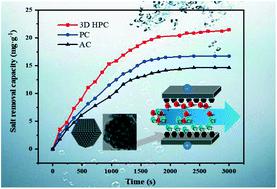当前位置:
X-MOL 学术
›
Environ. Sci.: Nano
›
论文详情
Our official English website, www.x-mol.net, welcomes your
feedback! (Note: you will need to create a separate account there.)
3D-ordered honeycomb-like nitrogen-doped micro–mesoporous carbon for brackish water desalination using capacitive deionization
Environmental Science: Nano ( IF 5.8 ) Pub Date : 2021-06-09 , DOI: 10.1039/d1en00276g Xue Song 1, 1, 2, 3, 4 , Dezhi Fang 1, 1, 2, 3, 4 , Silu Huo 1, 1, 2, 3, 4 , Kexun Li 1, 1, 2, 3, 4
Environmental Science: Nano ( IF 5.8 ) Pub Date : 2021-06-09 , DOI: 10.1039/d1en00276g Xue Song 1, 1, 2, 3, 4 , Dezhi Fang 1, 1, 2, 3, 4 , Silu Huo 1, 1, 2, 3, 4 , Kexun Li 1, 1, 2, 3, 4
Affiliation

|
Capacitive deionization (CDI) is currently one of the most popular methods in the field of desalination and its performance highly depends on the electrode materials. It is vital to reasonably design the structure of the electrode material to obtain high CDI salt adsorption capacity. In this work, an ordered porous structure was constructed from ZIF-8 by a novel sacrifice template method to obtain 3D-ordered honeycomb-like nitrogen-doped micro–mesoporous carbon materials (3D HPC). Its unique double continuous wall and hole structure facilitated the penetration and transport of ions and also improved the specific surface area utilization to provide active sites. Moreover, in situ nitrogen-doped 3D HPC improved the electrosorption of salt ions through the increased conductivity of 3D HPC. The electrochemical behavior of 3D HPC electrodes was analyzed through a series of electrochemical tests such as cyclic voltammetry, galvanostatic charge–discharge and electrochemical impedance spectroscopy. The results show that 3D HPC has the advantages of low internal resistance, high reversibility and good stability. Through batch electrosorption experiments, the desalination ability of 3D HPC in NaCl aqueous solution was evaluated. The 3D HPC-based CDI electrodes displayed a maximum salt adsorption capacity of 21.45 mg g−1 in 500 mg L−1 NaCl solution at 1.2 V. The outstanding desalination performance and cycle stability proved its bright prospects for application in CDI.
中文翻译:

3D有序蜂窝状氮掺杂微介孔碳用于电容去离子淡化苦咸水
电容去离子(CDI)是目前海水淡化领域最流行的方法之一,其性能在很大程度上取决于电极材料。合理设计电极材料的结构对于获得高CDI盐吸附能力至关重要。在这项工作中,通过新的牺牲模板方法从 ZIF-8 构建了有序多孔结构,以获得 3D 有序蜂窝状氮掺杂微介孔碳材料(3D HPC)。其独特的双连续壁和孔结构促进了离子的渗透和传输,也提高了比表面积利用率,提供了活性位点。此外,就地氮掺杂的 3D HPC 通过增加 3D HPC 的电导率改善了盐离子的电吸附。通过循环伏安法、恒电流充放电和电化学阻抗谱等一系列电化学测试分析了 3D HPC 电极的电化学行为。结果表明,3D HPC具有内阻低、可逆性高、稳定性好等优点。通过批量电吸附实验,评估了3D HPC在NaCl水溶液中的脱盐能力。基于 3D HPC 的 CDI 电极在 1.2 V 的500 mg L -1 NaCl 溶液中显示出 21.45 mg g -1的最大盐吸附容量。出色的脱盐性能和循环稳定性证明了其在 CDI 中的应用前景广阔。
更新日期:2021-07-19
中文翻译:

3D有序蜂窝状氮掺杂微介孔碳用于电容去离子淡化苦咸水
电容去离子(CDI)是目前海水淡化领域最流行的方法之一,其性能在很大程度上取决于电极材料。合理设计电极材料的结构对于获得高CDI盐吸附能力至关重要。在这项工作中,通过新的牺牲模板方法从 ZIF-8 构建了有序多孔结构,以获得 3D 有序蜂窝状氮掺杂微介孔碳材料(3D HPC)。其独特的双连续壁和孔结构促进了离子的渗透和传输,也提高了比表面积利用率,提供了活性位点。此外,就地氮掺杂的 3D HPC 通过增加 3D HPC 的电导率改善了盐离子的电吸附。通过循环伏安法、恒电流充放电和电化学阻抗谱等一系列电化学测试分析了 3D HPC 电极的电化学行为。结果表明,3D HPC具有内阻低、可逆性高、稳定性好等优点。通过批量电吸附实验,评估了3D HPC在NaCl水溶液中的脱盐能力。基于 3D HPC 的 CDI 电极在 1.2 V 的500 mg L -1 NaCl 溶液中显示出 21.45 mg g -1的最大盐吸附容量。出色的脱盐性能和循环稳定性证明了其在 CDI 中的应用前景广阔。











































 京公网安备 11010802027423号
京公网安备 11010802027423号